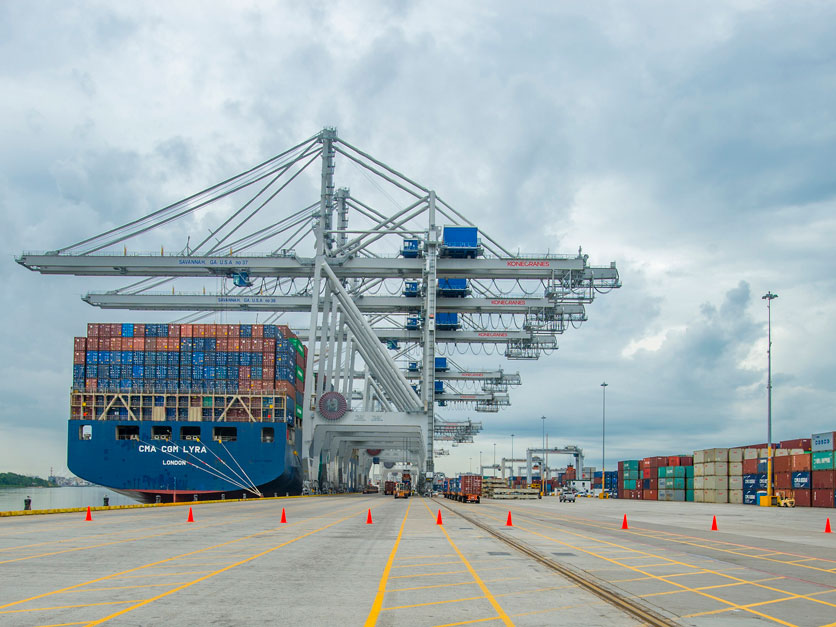The Biden administration spent much of 2021 assessing the trade landscape left by the Trump administration, but the U.S. ag sector is looking for a new agenda in 2022 as uncertainties, concerns and opportunities lie ahead.
China is no longer obliged to buy U.S. ag commodities under the "phase one" trade deal, the threat of new trade disputes with Mexico and Canada looms, the World Trade Organization’s dispute resolution system is broken, much-needed fertilizer imports are weighed down by U.S. duties, and ports are still failing U.S. ag exporters that need to get their commodities overseas.
The Build Back Better threat to US ag trade
Perhaps one of the biggest threats on the horizon to U.S. ag trade is the potential for new trade clashes with Mexico and Canada over a provision in President Joe Biden’s Build Back Better legislation. Within the $2 trillion package of climate measures and social program spending is a provision to give tax credits for electric vehicles built by domestic carmakers, which has sparked threats of retaliation by Mexican Economy Minister Tatiana Clouthier and Canadian Minister of Small Business, Export Promotion and International Trade Mary Ng.
“Mexico is a key market for U.S. dairy and other agricultural product,” said U.S. Dairy Export Council (USDEC) Executive Vice President Jaime Castaneda. “It’s vital that we carefully manage our trade relationship with them as any increased tensions between both countries could result in added trade barriers.”
 Jaime Castaneda, USDEC
Jaime Castaneda, USDECWhile Mexico is the third-largest foreign market for U.S. agricultural exports, it is the largest importer of U.S. dairy. And that makes it an easy target for retaliation. Mexico has levied tariffs on U.S. dairy in response to U.S. duties on steel and aluminum and in just about every other trade dispute.
“How we go about managing our relationship with Mexico is a priority and it is key for (2022),” said Castaneda.
Still, the fate of Build Back Better is unclear. The House passed it, but the Senate still doesn’t have the votes to do the same in its present state.
Mexico’s biotech problem
Mexico is also the largest foreign market for U.S. corn, but it’s a different threat to that trade that has U.S. grain farmers hoping for attention from the Biden administration.
U.S. corn exports are forecast to have another big year in 2022, and Mexico’s growing hostility to biotechnology should be a U.S. priority, says National Corn Growers Association (NCGA) President Chris Edgington.
Mexico has not approved a new ag biotech trait since May of 2018, creating a bottleneck that is now blocking about two dozen corn, canola, soybean, potato and apple traits.
“We have to get more engaged,” Edgington tells Agri-Pulse. “We have to make sure that (Mexican President Andrés Manuel López Obrador) fully recognizes that his rhetoric is anti-USMCA.”
US ag needs a renewed WTO
The U.S. has shown no signs of releasing its stranglehold on the appointment of appellate court judges at the WTO, but U.S. farm groups and lawmakers are still pressing the Biden administration to bring new trade challenges to the organization.
Sen. John Boozman, R-Ark., and 17 of his colleagues are pushing for a challenge this year to India’s wheat and rice subsidies.
“American rice and wheat producers are operating at a clear disadvantage compared to their competitors, primarily from India, where the government is subsidizing more than half of the value of production for rice and wheat, instead of the 10 percent allowable under [WTO] rules,” the senators said in a letter last month to U.S. Agriculture Secretary Tom Vilsack and U.S. Trade Representative Katherine Tai.
National Association of Wheat Growers CEO Chandler Goule says India’s massive supports make U.S. farmers less competitive on the international market.
“Wheat and rice farmers rely on open markets and fair trade to facilitate trade, which plays a vital role in supporting our growers and jobs in rural America,” Goule said. “It is important that as a WTO member, India adhere to international commitments and not continue to create unfair advantages for its domestic production and distort world trade.”
China
China’s commitments to purchase U.S. agriculture under the “phase one” trade pact expired on Dec. 31. That has some farm leaders concerned — especially after Tai announced that she would be focusing on enforcing “phase one” rather than negotiating new deals with China.
While China’s purchase commitments have expired, the policies that opened up new trade by removing non-tariff barriers remain in place, and that’s going to mean U.S. beef exports to China will continue to expand rapidly, said Ethan Lane, vice president of government affairs for the National Cattlemen’s Beef Association.
Looking for the best, most comprehensive and balanced news source in agriculture? Our Agri-Pulse editors don't miss a beat! Sign up for a free month-long subscription by clicking here.
“We’ve gone from zero to a $1 billion market in no time flat,” Lane told Agri-Pulse. “I think it’s reasonable to assume that (China) will be our biggest export market in fairly short order over the next 18 months.”
It was under the trade deal that the Chinese agreed to lift their zero-tolerance policy on growth hormones, eliminate a prohibition on beef from cattle over 30 months old at slaughter, accept the U.S. traceability system, and make it much easier for U.S. packers to be approved for trade with the country.
Soon after “phase one” was negotiated the USDA announced that nearly a thousand U.S. beef and pork plants were eligible to export to China.
It’s a lot of trade, says Lane — maybe too much.
“The next question is how big does it get,” he said. “There’s a point where there’s too much trade as far as what we have the ability to process and ship.”
A Biden trade agenda?
Beyond relatively ambiguous references to the rising importance of an Indo-Pacific agenda — reaching a broad expanse of geography that stretches across the Pacific and Indian Oceans to include the U.S., India, Australia, the Philippines, Vietnam and other Asian countries — the Biden administration has not yet laid out a vision for new trade alliances. U.S. ag groups hungry for tariff-slashing free trade agreements are hoping that will happen in 2022.
“Unfortunately, we haven’t had as much action this last year as we would like on trade,” said Edgington. “All of Southeast Asia — we can do more there. We can do more free trade agreements.”
 Chris Edgington, NCGA
Chris Edgington, NCGAA key component of any agenda will be reauthorizing Trade Promotion Authority, and groups like NCGA and USDEC are hoping that happens early this year.
Much of the U.S. ag sector was stunned when the Trump administration pulled the U.S. out of the Trans-Pacific Partnership and the Biden administration’s decision to allow TPA — legislation that allows the president to ensure a trade deal will be submitted to Capitol Hill for an up-or-down vote without the threat of Congress amending it — to expire on July 1.
Reauthorizing TPA early this year would be seen as a signal that the Biden administration intends to focus on expanding trade opportunities.
“Now that the administration has made headway on multiple domestic fronts and staffed up over the past year, the U.S. dairy industry is eager to see the administration move forward with pursuing new trade opportunities that would address tariff and nontariff market access barriers to expanding exports of American-made dairy products,” Castaneda said.
“New opportunities for dairy sales in key markets like the UK, Southeast Asia, Japan, China and the Middle East are vital for dairy farmers and exporters, as they are for others in American agriculture," he said. "We can’t afford to cede these markets to our competitors like the EU and New Zealand that are much more aggressively negotiating trade agreements that give their producers a leg up around the world while the U.S. hasn’t implemented a new trade agreement in a decade. We need to design a new TPA in a way that meets the needs of U.S. workers, farmers and manufacturers and get moving on new trade agreements.”
For more news, go to www.Agri-Pulse.com.


